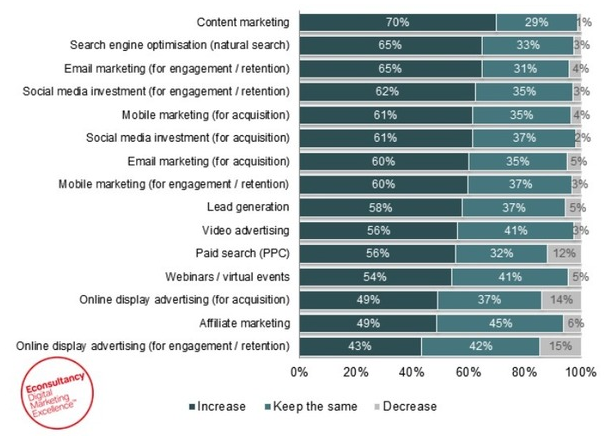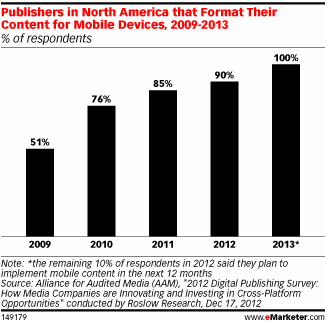Demand for complex digital marketing collateral has led brands to believe their online campaigns need as many bells and whistles as possible. Marketers can’t ignore the potential for high-quality video marketing and interactive social outreach to drive awareness, sales and more, but companies can’t forget the basics in an attempt to get ahead of the competition. Site visitors and search crawlers look for good website copy to back up traffic-drawing content.
Whenever Google refreshes its Panda algorithm, companies take a step back and remember the value of quality content. While it’s important to use several channels to reach prospects – B2Bs and B2Cs both use an average of 12 tactics – brands can’t neglect their daily blogs or core landing pages, or else their content marketing strategies will collapse under their inflated campaigns. In January 2013, Google issued its latest Panda refresh, affecting approximately 1.2 percent of English queries. It might be a good idea for marketers to spend some time relearning the basics of content creation, the benefits the practice provides brands and how global companies plan to use the tactic over the next 12 months.
In 2012, business owners indicated that they would focus on crafting thorough content marketing strategies to engage their audiences online. While custom content creation remains an important practice in 2013, professionals recognize that their strategies must evolve to build online narratives that draw in audiences, not just increase PageRank in SERPs.
How brands will strengthen their content marketing strategies in 2013
 B2B and B2C brands established credibility through web content last year, with 91 percent of business-facing and 86 percent of customer-facing organizations crafting digital content for lead generation purposes. The practice evolved quickly to include a variety of other tactics such as video content, infographic marketing content and social media content. However, challenges still prevent a wide percentage of companies from thriving online. BusinessBolts.com discovered that while 74 percent of marketers use branded content to increase website traffic, a comparable amount fail to understand how to leverage SEO content for greater site visibility. Working with content writers who can effectively incorporate keywords into pieces and seamlessly use targeted phrases in metadescriptions and titles is an essential step to getting a leg up in search this year.
B2B and B2C brands established credibility through web content last year, with 91 percent of business-facing and 86 percent of customer-facing organizations crafting digital content for lead generation purposes. The practice evolved quickly to include a variety of other tactics such as video content, infographic marketing content and social media content. However, challenges still prevent a wide percentage of companies from thriving online. BusinessBolts.com discovered that while 74 percent of marketers use branded content to increase website traffic, a comparable amount fail to understand how to leverage SEO content for greater site visibility. Working with content writers who can effectively incorporate keywords into pieces and seamlessly use targeted phrases in metadescriptions and titles is an essential step to getting a leg up in search this year.
In addition, Econsultancy and Responsys unveiled a new study that found 71 percent of global brands will increase their digital marketing budgets this year, with 70 percent focusing on content creation. How can organizations bring their content efforts to the next level to show greater returns? It may be time to build out the site’s overall user experience, using SEO content to round-out the campaign. BtoB Magazine found that 93 percent of marketers will allocate resources toward improving their websites in 2013. This could be a sweeping trend that highlights greater demand for sustainable website development and complementary content.
How else can companies improve their contents’ power online?
For many organizations, tackling mobile marketing seems beyond their budgets. The web moves at such a fast pace that new tech trends can leave companies in the dust. The good news: Brands don’t need to develop mobile applications to reach their on-the-go customers.
 According to the CMI, 43 percent of B2C and 33 percent of B2B brands create mobile content to reach their audiences. This media type can be as basic as custom copy optimized for mobile viewers, and the Alliance for Audited Media predicts that 2013 will be the first year where nearly 100 percent of publishers will format their content for various screens. This report notes that mobile content can reach and influence shoppers just as effectively as applications, but for fractions of the cost. More, U.S. consumers continue to use their mobile devices more frequently than ever before, searching the ‘net for specific information while on the go.
According to the CMI, 43 percent of B2C and 33 percent of B2B brands create mobile content to reach their audiences. This media type can be as basic as custom copy optimized for mobile viewers, and the Alliance for Audited Media predicts that 2013 will be the first year where nearly 100 percent of publishers will format their content for various screens. This report notes that mobile content can reach and influence shoppers just as effectively as applications, but for fractions of the cost. More, U.S. consumers continue to use their mobile devices more frequently than ever before, searching the ‘net for specific information while on the go.
According to data from IgnitionOne, smartphones accounted for 18 percent of total U.S. search spend in the fourth quarter of 2012, while tablet spend grew by 163 percent when compared to the previous year. Brands have started to develop strategies to reach these prospective customers, and tactics which have already proven to work via personal computers can be the cornerstone of mobile marketing.
As content marketing evolves alongside web media, the level of depth marketers must create for their campaigns will rise substantially. The volume of content types will ever increase, but marketers must remember their bread and butter – don’t forget to lay the foundation before starting to build.




